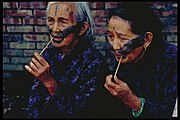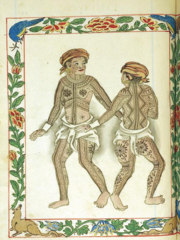
A face tattoo or facial tattoo is a tattoo located on the bearer's face or head. It is part of the traditional tattoos of many ethnic groups.
In modern times, although it is considered taboo and socially unacceptable in many cultures, as well as considered extreme in body art, this style and placement of tattoo has emerged in certain subcultures. This is due to the continuing acceptance of tattoos and the emergence of hip-hop culture popularizing styles such as the teardrop tattoo.
Traditions
Face tattooing is traditionally practiced by many ethnic groups worldwide.
As indicator of status, maturity, or beauty
Ainu

The Ainu people of northern Japan and parts of Russia, including Sakhalin, the Kuril Islands and Kamchatka Krai, have a practice of facial tattooing exclusive to women, in which a smile is inked around the mouth to prevent spirits from entering the body through the mouth. This form of tattooing also serves a secondary purpose of showing maturity.
Atayal

In Taiwan, facial tattoos of the Atayal people are called ptasan; they are used to demonstrate that an adult man can protect his homeland, and that an adult woman is qualified to weave cloth and perform housekeeping.
Cordillerans

Among the various Cordilleran (Igorot) peoples of the northern Philippines, facial tattoos indicated that a warrior belonged to the highest rank.
Among the Kalinga people, pregnant women were also tattooed with small x-shaped marks on the forehead, cheeks, and the tip of the nose to protect them and the unborn child from the vengeful spirits of slain enemies.
Inuit and Alaskan and Canadian Natives

Facial tattoos were practiced among Inuit women, but this practice was suppressed by missionaries. Yidįįłtoo are the traditional face tattoos of the Hän Gwich’in, who are indigenous to Alaska and Canada. Kakiniit and Tavlugun are other examples.
In the 21st century, there was a revival of traditional facial tattooing among Indigenous Arctic women. Quannah Chasinghorse wears Yidįįłtoo.
Māori
Main article: Tā mokoAmong the Māori people, men traditionally received tattoos on the entire face, while in women it was mostly restricted to the lips (kauwae) and chins. These tattoos were traditionally part of the initiation into adulthood and signified rank and status, as well as being considered beautiful.
Medieval Europe
Medieval pilgrims would frequently get tattoos whilst visiting the Holy Land, including the occasional face tattoo. Crusaders may have got facial tattoos as permanent proof of their participation in the Crusades, although this is unknown.
Middle East/North Africa
Facial tattoos are widespread across various parts of the Middle East and parts of North Africa. In the Levant, facial tattoos are primarily adorned by the women of the Bedouin tribes living throughout Jordan to symbolize beauty and social status. In some instances tattoos are also used for their believed "magick" properties. Facial markings are also seen in Iraq among the Yezidi women. In North Africa, face tattoos can be found among the indigenous Berbers that populated the region before the arrival of Arab armies from the East. Egyptian women from different religious sub-sects of Islam and Christianity also sport face tattoos. In all cases, it is primarily the women that adorn facial markings and while men did have tattoos in some cases, they were primarily on the hands, arms, and feet. The tattoos throughout the Middle East and Africa share many similarities in the use and style of the geometric designs and glyphs that symbolize various animals, element signs, and physical attributes.
Visayans
Main article: Batok
Among the heavily-tattooed Visayans of the central and southern Philippines, face tattoos were known as bangut or langi. They were often meant to resemble frightening masks, like crocodile jaws or raptorial beaks. These tattoos were reserved only for the most elite warriors (timawa), and possessing facial tattoos indicated high personal status.
As deterrent from abduction
Apatani
Among the Apatani people in Arunachal Pradesh in India, women used to tattoo lines on the chin, and from the forehead to the tip of the nose, as well as wear large nose plugs. The reason for this is unknown, but it is believed that the tattoos serve as a way to make women less beautiful and protect them from abductions. Men also had a T-shaped tattoo on the chin. These traditions were practiced up until around 1974.
Chin people
See also: Tattooing in Myanmar
Southern Chin women were also tattooed on their faces with closely set lines using blue pigments, ostensibly to discourage them from being kidnapped by invaders. Chin women were typically tattooed between the ages of 15 and 20. The practice has quickly disappeared, as it was banned in the 1960s by Burma's totalitarian regime and it was discouraged by Christian missionaries. Mro women also wore tattoos in the form of small marks or stars on the cheek, forehead or breast.
Derung
The Derung people of southwestern China practiced facial tattooing only for women. They receive these tattoos at around age 12. The practice is believed to make the women less attractive and thus less likely to be abducted.
As punishment
Ancient Rome
In Ancient Rome, slaves who fled or attempted escape from their masters would frequently be branded on their foreheads or tattooed against their will. These tattoos portrayed the crimes committed and were a punishment because of the inability to cover up a tattoo on the forehead. As the Roman world entered late antiquity, extreme Christian sects began to use former-slave forehead tattoos as religious symbols and signs of strength. Religious facial and head tattoos were not socially unacceptable within these circles though in the greater Roman mainstream there was still an association between face tattoos and former slavery. In 315/316 CE, an edict outlawed facial tattoos and facial branding/tattooing for slaves.
Vietnam
In ancient Vietnam, face tattooing was considered as a form of punishment. In 1042, King Ly Thai Tong issued the Hinh Thu, or Criminal Law, in which criminals were caned or tattooed 20 to 50 characters on their faces.
Modern day
This section has multiple issues. Please help improve it or discuss these issues on the talk page. (Learn how and when to remove these messages)
|

Face tattoos have been considered socially unacceptable and "outrageous" and generally will prohibit the tattooed person from finding employment and result in discrimination. Most tattoo artists will attempt to dissuade clients from getting a facial tattoo, and in some cases may outright refuse to do a facial tattoo. Artists may be more agreeable to doing facial tattoos for heavily tattooed clients.
Due to how tattoos were used in the 20th century, they are often associated with criminality. Many gangs and criminal organizations mark members with tattoos, including visible areas such as the face, head, and neck. Members may get facial tattoos as a form of intimidation. This started in California in the 1980s before becoming widespread.
A 2013 study published in Psychology, Public Policy, and Law concluded that face tattoos often lead to bias in the jury and more frequent convictions. Many ex-convicts also have facial tattoos, due to prison tattooing, and the culture of prison tattoos includes the indoctrination of people within the prison populace into gangs, which often require tattoos to show aggression. These tattoos include teardrop tattoos indicating that the bearer has either taken a life or lost someone close to them; a five-point crown, a common Latin Kings symbol; and a number of different facial tattoos alluding to Nazism in the Aryan Brotherhood and Salvadorian culture in MS-13.
In the mid 2000s, the trend of getting a facial tattoo emerged among celebrities, starting with boxer Mike Tyson's large tribal tattoo in 2003 and the ascension of rap music from the underground to the mainstream. This allowed artists with a criminal background and face tattoos to become well known, including Birdman, Lil Wayne and The Game. Lil Wayne's extensive tattooing of his face created a minor trend that he helped pioneer inspiring rappers like Gucci Mane and then-chart topper Soulja Boy to get facial tattoos.
Though discrimination remains in the fashion world for models who have facial tattoos, generally models with face tattoos of the brand they're modeling for, such as having a Chanel logo under your eye, is becoming acceptable.
Hip-hop culture
The influence of artists like Lil Wayne and Fredo Santana getting face tattoos was not fully realized until the mid-2010s with the resurgence of trap music and the "SoundCloud rap" scene. Artists such as Ghostemane, Travis Scott, 21 Savage and Migos all have facial tattoos and emerged between 2014 and 2016, soon entering the mainstream and the Billboard Hot 100. Entrance of hip-hop culture into the mainstream has led to face tattoos increasing in popularity. The insurgence of many trap artists in the 2010s increased the popularity of face tattoos.
See also
References
- "'I lost a job because of my tattoos'". BBC News. 2014-09-22. Retrieved 2018-10-23.
- "Why Many Tattoo Artists Won't Ink Hands, Feet, or Faces". LiveAbout. Retrieved 2018-10-23.
- Kurutz, Steven (4 August 2018). "Face Tattoos Go Mainstream". The New York Times. Retrieved 2018-10-23.
- Prescott, Autumn. "Tattoos should not be taboo in society". The Eclipse. Retrieved 2018-10-23.
- "So why do 'normal' people get tattoos?". 2007-10-09. Retrieved 2018-10-23.
- "紋面". 臺灣原住民族歷史語言文化大辭典.
- Worcester, Dean C. (September 1912). "Head-hunters of Northern Luzon". The National Geographic Magazine. 23 (9): 833–930.
- Krutak, Lars (23 November 2012). "Return of the Headhunters: The Philippine Tattoo Revival". LarsKrutak.com. Retrieved 15 August 2021.
- Calano, Mark Joseph (October 2012). "Archiving bodies: Kalinga batek and the im/possibility of an archive". Thesis Eleven. 112 (1): 98–112. doi:10.1177/0725513612450502. S2CID 144088625.
- De Las Peñas, Ma. Louise Antonette N.; Salvador-Amores, Analyn (March 2019). "Enigmatic Geometric Tattoos of the Butbut of Kalinga, Philippines". The Mathematical Intelligencer. 41 (1): 31–38. doi:10.1007/s00283-018-09864-6. S2CID 126269137.
- Frey, Kaitlyn (14 December 2021). "Quannah Chasinghorse Didn't Want to Discuss Her Face Tattoo Because People 'Wouldn't Have Accepted'". People. Retrieved 2022-07-29.
- Hughes, Zachariah; Media, Alaska Public (2015-09-18). "More than ink: Traditional tattoos roar back in Alaska". Alaska Public Media. Retrieved 2019-10-29.
- Allford, Jennifer (2019-10-23). "Reclaiming Inuit culture, one tattoo at a time". Retrieved 2020-01-14.
- Pritchard, Stephen (2000-12-01). "Essence, Identity, Signature: Tattoos and Cultural Property". Social Semiotics. 10 (3): 331–346. doi:10.1080/10350330050136389. ISSN 1035-0330. S2CID 12023136.
- "Inside the World's Only Surviving Tattoo Shop For Medieval Pilgrims". Atlas Obscura. 2016-08-18. Retrieved 2018-10-23.
- Lewy, Mordechay. "Jerusalem under the skin - pilgrim tattoos promoted by the Franciscans in the Holy Land.ppt".
{{cite journal}}: Cite journal requires|journal=(help) - Kristensen, Troels Myrup (2012). "Textiles, Tattoos and the Representation of Pilgrimage in the Roman and Early Christian Periods (2012)". HEROM 1: The Material Culture of Roman and Early Christian Pilgrimage, Pp. 107-134. 1: 107–134.
- "Center for Tattoo History and Culture". Center for Tattoo History and Culture. Retrieved 2018-10-23.
- Scott, William Henry (1994). Barangay: Sixteenth-century Philippine Culture and Society. Ateneo University Press. pp. 20–27. ISBN 9789715501354.
- Salvador-Amores, Analyn. Burik: Tattoos of the Ibaloy Mummies of Benguet, North Luzon, Philippines. In Ancient Ink: The Archaeology of Tattooing, edited by Lars Krutak and Aaron Deter-Wolf, pp. 37–55. University of Washington Press, Seattle, Washington.
- Chanda, Aishik (1 October 2017). "Arunachal's Apatani tribe won't get inked: Dropping traditions in fear of discrimination". The New Indian Express. Retrieved 14 August 2021.
- White, Herbert Thirkell (2011). Burma. Cambridge University Press. ISBN 9781107600676.
- Myo Myo. "A symbol of Chin identity fades away". Myanmar Times. Archived from the original on 14 February 2013. Retrieved 27 September 2013.
- "Tattooed Chin women lure tourists to remote region". Myanmar Times. 25 April 2011. Archived from the original on 8 October 2013. Retrieved 27 September 2013.
- Nyein Ei Ei Htwe (17 November 2013). "Chin tattoos: a fading tradition". Myanmar Times. Retrieved 1 July 2015.
- Gait, Edward Albert (1902). Census of India, 1901. Vol. 12. Office of the Superintendent of Government Printing.
- "The Derung People: the Face Tattooed Tribal Women of China". China-Underground. 22 September 2016. Retrieved 14 August 2021.
- Jones, C. P. (1987). "Stigma: Tattooing and Branding in Graeco-Roman Antiquity". The Journal of Roman Studies. 77: 139–155. doi:10.2307/300578. JSTOR 300578. S2CID 162719864.
- Bond, Sarah. "Tattoo Taboo? Exploring The History Of Religious Ink And Facial Tattoos". Forbes. Retrieved 2018-10-23.
- "IMPERATORIS THEODOSII CODEX liber nonus". ancientrome.ru. Retrieved 2018-10-23.
- Donald G, Mccloud (2018). Southeast Asia: Tradition And Modernity In The Contemporary World, Second Edition. Routledge. ISBN 9780813318967.
- "Ever Wonder Why People Get Face Tattoos? Here's The Answer From 9 People Who Did". HuffPost UK. 2013-09-06. Retrieved 2018-10-23.
- "Tattooed People May Be More Likely to Find Employment". Loudwire. Retrieved 2018-10-23.
- "Research reveals how your tattoos affect your chances of getting the job - Workopolis Blog". Workopolis Blog. 2014-10-06. Retrieved 2018-10-23.
- "Can a Tattoo Really Cost You a Job?". SalesHQ. Retrieved 2018-10-23.
- "Discrimination against tattoos in the workplace- Attwells Solicitors LLP". Attwells Solicitors LLP. Retrieved 2018-10-23.
- "YouGov | That inking feeling: the tattoos employers don't want to see". YouGov: What the world thinks. Retrieved 2018-10-23.
- Kelly, Jon (2014-08-18). "Should anti-tattoo discrimination be illegal?". BBC News. Retrieved 2018-10-23.
- "You want a good job – but you also want a facial tattoo. What should you do?". the Guardian. 2018-06-10. Retrieved 2018-10-23.
- "Dress codes, tattoos, piercings and discrimination - QCS". QCS. 2017-03-16. Retrieved 2018-10-23.
- "Tattoos That Tattoo Artists Refuse To Do". 2018-04-06. Retrieved 2018-10-23.
- Codrea-Rado, Anna (2015-08-09). "Are tattoo artists right to refuse to adorn necks and hands?". the Guardian. Retrieved 2018-10-23.
- "Neck Tattoos, And Why Your Artist Won't..." Tattoodo. Retrieved 2018-10-23.
- "Tattoos many tattoo artists hate to do". TheList.com. 12 March 2017. Retrieved 2018-10-23.
- "A statistical analysis of the art on convicts' bodies". The Economist. Retrieved 2018-10-23.
- WRAL. "Blink and you won't miss it: Face tattoos go mainstream :: WRAL.com". WRAL.com. Retrieved 2018-10-23.
- "Hip-Hop Ink: Gang Tattoos Explained". HotNewHipHop. Retrieved 2018-10-23.
- Nelson, Patrick (2017-11-30). "Face tattoos a trend for Valley crime suspects". YOURCENTRALVALLEY. Retrieved 2018-10-23.
- "Inked into Crime? An Examination of the Causal Relationship between Tattoos and Life-Course Offending among Males from the Cambridge Study in Delinquent Development". ResearchGate. Retrieved 2018-10-23.
- Dajani, Daniel D. (May 12, 2017). "Tattoos and Criminal Behavior: An examination of the relationship between body art and crime". City University of New York (CUNY). Archived from the original on 2023-02-22.
- "Where All the Madness Began: A Look at Gang History". web.stanford.edu. Retrieved 2018-10-23.
- Funk, Friederike; Todorov, Alexander (2013). "Criminal stereotypes in the courtroom: Facial tattoos affect guilt and punishment differently". Psychology, Public Policy, and Law. 19 (4): 466–478. doi:10.1037/a0034736. ISSN 1939-1528.
- "15 common prison tattoos and what they mean". Business Insider. Retrieved 2018-10-23.
- "Another inmate with a tattooed face escapes". The Mercury News. 2017-11-28. Retrieved 2018-10-23.
- "7 Most Notorious Prison Tattoos & What They Mean". RealClear. Retrieved 2018-10-23.
- "Hate on Display™ Hate Symbols Database". Anti-Defamation League. Retrieved 2018-10-23.
- "Mike Tyson sees no downside to his face tattoo". SI.com. Retrieved 2018-10-23.
- "A Guide to Celebrity Face TattoosLil Wayne". Complex. Retrieved 2018-10-23.
- Tijerina, Daniela (2018-07-31). "Face-Tat Fever". Rolling Stone. Retrieved 2018-10-23.
- Perpetua, Matthew (2011-01-13). "What Does Gucci Mane's Ice Cream Cone Tattoo Mean?". Rolling Stone. Retrieved 2018-10-23.
- "Soulja Boy Says Goodbye To The Gucci Logo Tattoo On His Forehead". Vibe. 2015-12-28. Retrieved 2018-10-23.
- "face tattoos in fashion: a controversial history". I-d. 2016-09-30. Retrieved 2018-10-23.
- "Rappers Break Down Lil Wayne's Lasting Impact". PigeonsandPlanes. Retrieved 2018-10-23.
- "Lil Uzi Vert Got His First Face Tattoo So He'd Have To Focus On Music". HotNewHipHop. Retrieved 2018-10-23.
- "Travis Scott Shows Off New Face Tattoo - XXL". XXL Mag. Retrieved 2018-10-23.
- "The Brutal Story Behind 21 Savage's Dagger Face Tattoo". DJBooth. Retrieved 2018-10-23.
- "HipHopDX's Handy Guide For Telling The Migos Apart". HipHopDX. Retrieved 2018-10-23.
- "Hip-Hop: From the Streets to the Mainstream - IIP Publications". IIP Publications. Retrieved 2018-10-23.
- Petridis, Alexis (2003-10-08). "Feature: Hip-hop has taken over mainstream pop culture". the Guardian. Retrieved 2018-10-23.
- "How Rap Became the Sound of the Mainstream". Time. Retrieved 2018-10-23.
- "The future has a face tattoo". The Outline. Retrieved 2018-10-23.
| Tattoos and tattooing | |||||||||||||||||
|---|---|---|---|---|---|---|---|---|---|---|---|---|---|---|---|---|---|
| Topics | |||||||||||||||||
| Types | |||||||||||||||||
| Process and technique | |||||||||||||||||
| Traditions and practices |
| ||||||||||||||||
| Styles and designs | |||||||||||||||||
| Bodily location | |||||||||||||||||
| Legal status | |||||||||||||||||